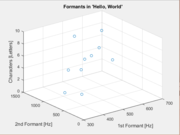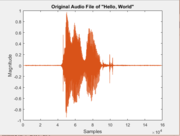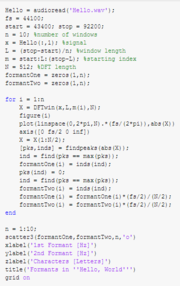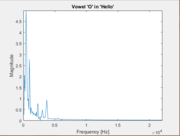| Line 1: | Line 1: | ||
| − | + | =Hello, World!= | |
| + | by Alden Fisher | ||
| + | ---- | ||
| + | == Introduction == | ||
My original intent was to insert an audio file into Matlab and have it print out what I was saying in plain text. This proved to be a challenge for several reasons which I will get to later. What I ended up doing instead was finding the 1st and 2nd formants in the famous sentence "Hello, world." | My original intent was to insert an audio file into Matlab and have it print out what I was saying in plain text. This proved to be a challenge for several reasons which I will get to later. What I ended up doing instead was finding the 1st and 2nd formants in the famous sentence "Hello, world." | ||
| + | <br><br> | ||
| + | |||
| + | == Challenges == | ||
| + | The toughest part of the original plan was in finding a table that mapped out the formants of the 42 phonemes [1] in the English language. This left me with nothing to compare my results to so the computer had no viable data to use. For this reason, I changed the direction of the project to the current goal. | ||
| + | |||
| + | == Approach == | ||
| + | I audio recorded me in a quiet room saying the phrase "Hello, World." This was recorded on my iPhone which has a sampling rate of 44.1kHz. From there, I converted the file [2] to a '.wav' so that it would be compatible on all computing platforms. | ||
| + | Once I had the audio file, I manually trimmed the data to, basically, get rid of any dead time. One assumption I made was that each of the 10 letters lasted the same amount of time. For this reason, I took 10 DFTs using the 'DFTwin' function we created in lab 9a [1]. From there, I extracted the first 2 largest peaks (the formants). Once I had these, I was able to plot them in 3-space with respect to the letters. | ||
| + | |||
| + | http://www.zamzar.com/ | ||
| + | |||
| + | |||
[[File:3D plot.PNG|thumbnail]] | [[File:3D plot.PNG|thumbnail]] | ||
Revision as of 23:33, 23 April 2017
Hello, World!
by Alden Fisher
Introduction
My original intent was to insert an audio file into Matlab and have it print out what I was saying in plain text. This proved to be a challenge for several reasons which I will get to later. What I ended up doing instead was finding the 1st and 2nd formants in the famous sentence "Hello, world."
Challenges
The toughest part of the original plan was in finding a table that mapped out the formants of the 42 phonemes [1] in the English language. This left me with nothing to compare my results to so the computer had no viable data to use. For this reason, I changed the direction of the project to the current goal.
Approach
I audio recorded me in a quiet room saying the phrase "Hello, World." This was recorded on my iPhone which has a sampling rate of 44.1kHz. From there, I converted the file [2] to a '.wav' so that it would be compatible on all computing platforms. Once I had the audio file, I manually trimmed the data to, basically, get rid of any dead time. One assumption I made was that each of the 10 letters lasted the same amount of time. For this reason, I took 10 DFTs using the 'DFTwin' function we created in lab 9a [1]. From there, I extracted the first 2 largest peaks (the formants). Once I had these, I was able to plot them in 3-space with respect to the letters.
https://en.wikipedia.org/wiki/International_Phonetic_Alphabet http://phonemicchart.com/transcribe/1000_basic_words.html





